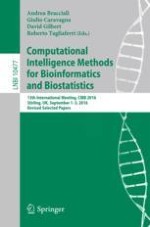2017 | Buch
Computational Intelligence Methods for Bioinformatics and Biostatistics
13th International Meeting, CIBB 2016, Stirling, UK, September 1-3, 2016, Revised Selected Papers
herausgegeben von: Andrea Bracciali, Giulio Caravagna, David Gilbert, Prof. Roberto Tagliaferri
Verlag: Springer International Publishing
Buchreihe : Lecture Notes in Computer Science
